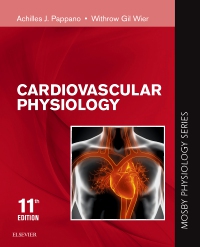
Cardiovascular Physiology - Elsevier eBook on VitalSource, 11th Edition
Elsevier eBook on VitalSource

-
- Helps you easily master the material in a systems-based curriculum with learning objectives, Clinical Concept boxes, highlighted key words and concepts, chapter summaries, self-study questions, and a comprehensive exam to help prepare for USMLEs.
- Keeps you current with the latest concepts in vascular, molecular, and cellular biology as they apply to cardiovascular function, thanks to molecular commentaries in each chapter.
- Includes clear, 2-color diagrams that simplify complex concepts.
- Features clinical commentaries that show you how to apply what you've learned to real-life clinical situations.
- Enhanced eBook version included with purchase. Your enhanced eBook allows you to access all of the text, figures, and references from the book on a variety of devices.
Complete the Mosby Physiology Series! Systems-based and portable, these titles are ideal for integrated programs.
- Blaustein, Kao, & Matteson: Cellular Physiology and Neurophysiology
- Cloutier: Respiratory Physiology
- Koeppen & Stanton: Renal Physiology
- Johnson: Gastrointestinal Physiology
- White, Harrison, & Mehlmann: Endocrine and Reproductive Physiology
- Hudnall: Hematology: A Pathophysiologic Approach
-
- Appendix - Comprehensive MCQ review examination
- Keywords/concepts
-
Chapter 1 OVERVIEW OF THE CIRCULATION AND BLOOD
The Circulatory System
Blood
Erythrocytes
Leukocytes
Lymphocytes
Platelets
Blood Is Divided into Groups by Antigens Located on Erythrocytes
Summary
Case 1-1
Chapter 2 EXCITATION: THE CARDIAC ACTION POTENTIAL
Cardiac Action Potentials Consist of Several Phases
The Principal Types of Cardiac Action Potentials Are the Slow and Fast Types
Ionic Basis of the Resting Potential
The Fast Response Depends Mainly on Voltage-Dependent Sodium Channels
Ionic Basis of the Slow Response
Conduction in Cardiac Fibers Depends on Local Circuit Currents
Conduction of the Fast Response
Conduction of the Slow Response
Cardiac Excitability Depends on the Activation and Inactivation of Specific Currents
Fast Response
Slow Response
Effects of Cycle Length
Summary
Case 2-1
Chapter 3 AUTOMATICITY: NATURAL EXCITATION OF THE HEART
The Heart Generates Its Own Pacemaking Activity
Sinoatrial Node
Ionic Basis of Automaticity
Overdrive Suppression
Atrial Conduction
Atrioventricular Conduction
Ventricular Conduction
An Impulse Can Travel Around a Reentry Loop
Afterdepolarizations Lead to Triggered Activity
Early Afterdepolarizations
Delayed Afterdepolarizations
Electrocardiography Displays the Spread of Cardiac Excitation
Scalar Electrocardiography
Dysrhythmias Occur Frequently and Constitute Important Clinical Problems
Altered Sinoatrial Rhythms
Atrioventricular Transmission Blocks
Premature Depolarizations
Ectopic Tachycardias
Fibrillation
Summary
Case 3-1
Chapter 4 THE CARDIAC PUMP
The Microscopic and Gross Structures of the Heart
Cardiac Muscle (myocardial) Cell Morphology
Structure of the Heart: Atria, Ventricles, and Valves
The Force of Cardiac Contraction Is Determined by Excitation-Contraction Coupling and the Initial Sarcomere Length of the Myocardial Cells
Excitation-Contraction Coupling Is Mediated by Calcium
Mechanics of Cardiac Muscle
The Sequential Contraction and Relaxation of the Atria and Ventricles Constitute the Cardiac Cycle
Ventricular Systole
Echocardiography Reveals Movement of the Ventricular Walls and of the Valves
The Two Major Heart Sounds Are Produced Mainly by Closure of the Cardiac Valves
The Pressure-Volume Relationships in the Intact Heart
Passive or Diastolic Pressure-Volume Relationship
Active or End-Systolic Pressure-Volume Relationship
Pressure and Volume during the Cardiac Cycle: The P-V Loop
Preload and Afterload during the Cardiac Cycle
Contractility
The Fick Principle Is Used to Determine Cardiac Output
Metabolism of ATP and its Relation to Mechanical Function
Fatty Acid Metabolism
Carbohydrate Metabolism
Interrelation between Fatty Acid and Carbohydrate Metabolism
Effects of plasma substrate and insulin levels
Cardiac O2 Consumption and the Link between Ventricular Function and Cardiac Metabolism
Summary
Case 4-1
Chapter 5 REGULATION OF THE HEARTBEAT
Heart Rate is Controlled Mainly by the Autonomic Nerves
Parasympathetic Pathways
Sympathetic Pathways
Higher Centers Also Influence Cardiac Performance
Heart Rate Can Be Regulated via the Baroreceptor Reflex
The Bainbridge Reflex and Atrial Receptors Regulate Heart Rate
Respiration Induces a Common Cardiac Dysrhythmia
Activation of the Chemoreceptor Reflex Affects Heart Rate
Ventricular Receptor Reflexes Play a Minor Role in the Regulation of Heart Rate
Myocardial Performance Is Regulated by Intrinsic Mechanisms
The Frank-Starling Mechanism Is an Important Regulator of Myocardial Contraction Force
Changes in Heart Rate Affect Contractile Force
Myocardial Performance Is Regulated by Nervous and Humoral Factors
Nervous Control
Cardiac Performance Is Also Regulated by Hormonal Substances
Summary
Case 5-1
Chapter 6 HEMODYNAMICS
Velocity of the Bloodstream Depends on Blood Flow and Vascular Area
Blood Flow Depends on the Pressure Gradient
Relationship Between Pressure and Flow Depends on the Characteristics of the Conduits
Resistance to Flow
Resistances in Series and in Parallel
Flow May Be Laminar or Turbulent
Shear Stress on the Vessel Wall
Rheologic Properties of Blood
Summary
Case 6-1
Chapter 7 THE ARTERIAL SYSTEM
The Hydraulic Filter Converts Pulsatile Flow to Steady Flow
Arterial Elasticity Compensates for the Intermittent Flow Delivered by the Heart
The Arterial Blood Pressure Is Determined by Physical and Physiological Factors
Mean Arterial Pressure
Cardiac Output
Peripheral Resistance
Pulse Pressure
Stroke Volume
Arterial Compliance
Total Peripheral Resistance and Arterial Diastolic Pressure
The Pressure Curves Change in Arteries at Different Distances from the Heart
Blood Pressure Is Measured by a Sphygmomanometer in Human Patients
Summary
Case 7-1
Chapter 8 The MICROCIRCULATION AND LYMPHATICS
Functional Anatomy
Arterioles Are the Stopcocks of the Circulation
Capillaries Permit the Exchange of Water, Solutes, and Gases
The Law of Laplace Explains How Capillaries Can Withstand High Intravascular Pressures
The Endothelium Plays an Active Role in Regulating the Microcirculation
The Endothelium is at the Center of Flow-Initiated Mechanotransduction
The Endothelium Plays a Passive Role in Transcapillary Exchange
Diffusion Is the Most Important Means of Water and Solute Transfer Across the Endothelium
Diffusion of Lipid-Insoluble Mole


 as described in our
as described in our 